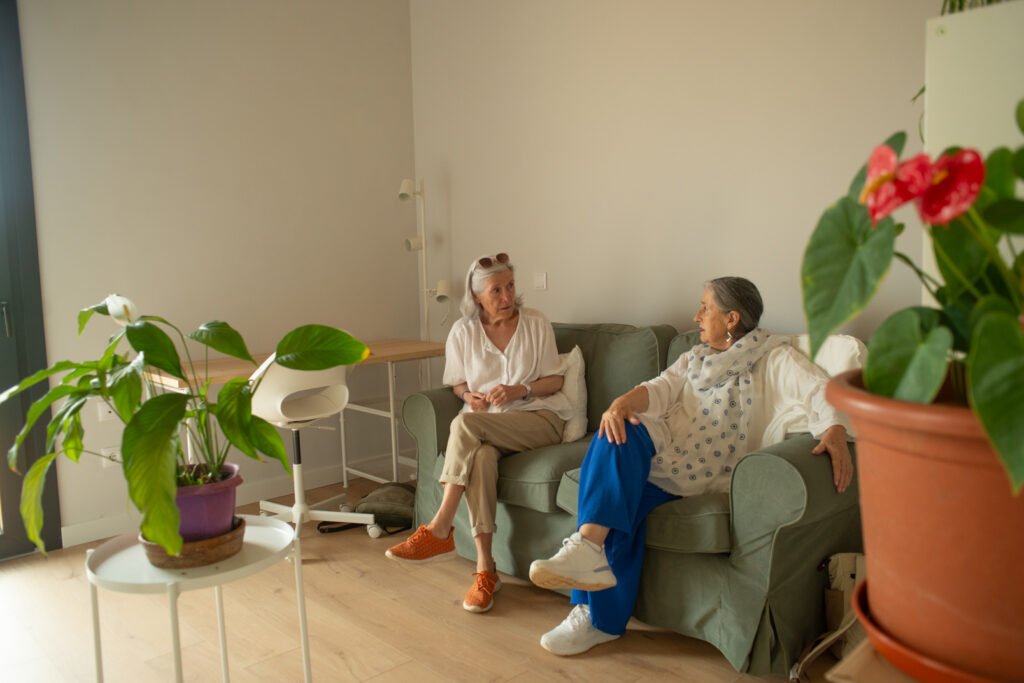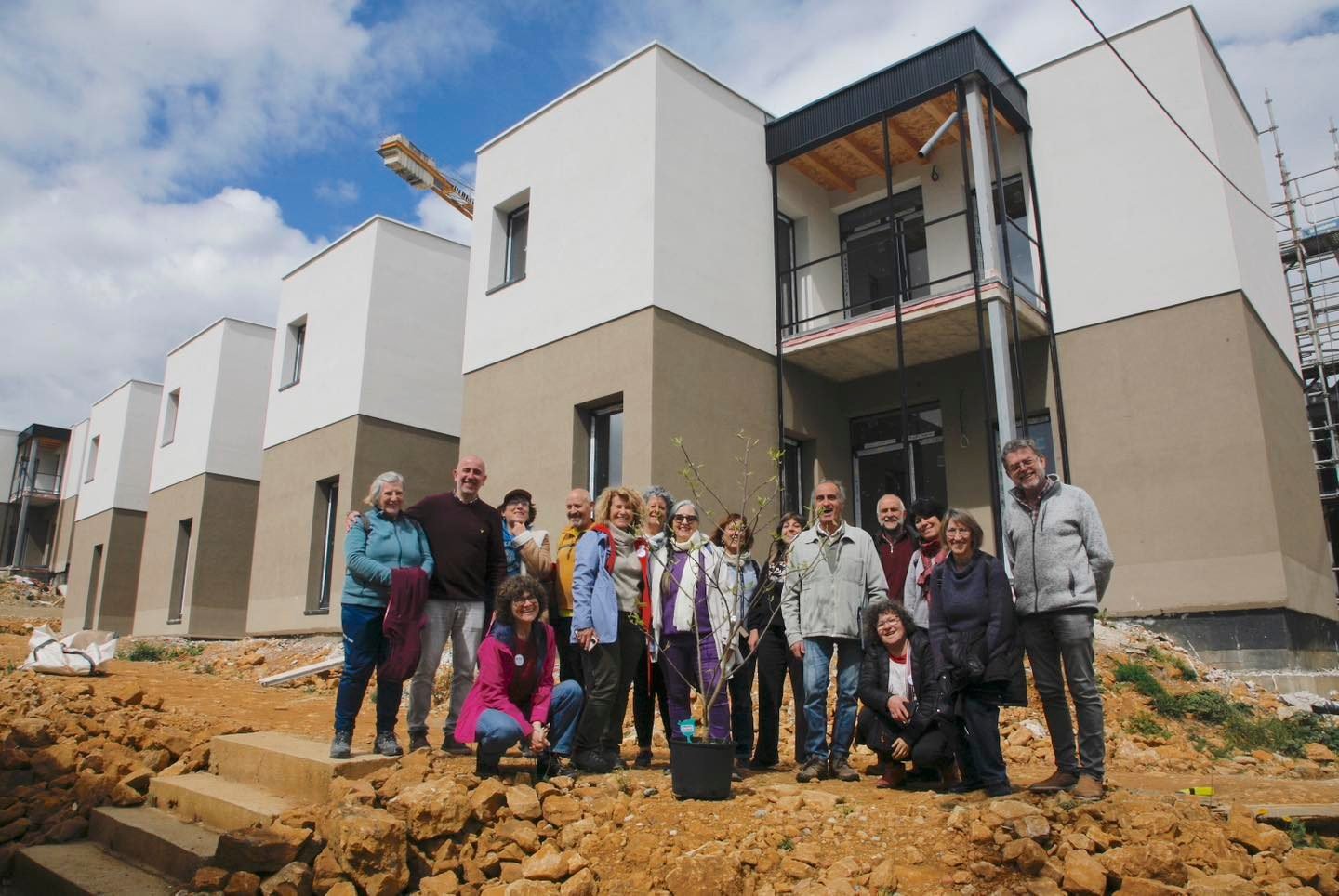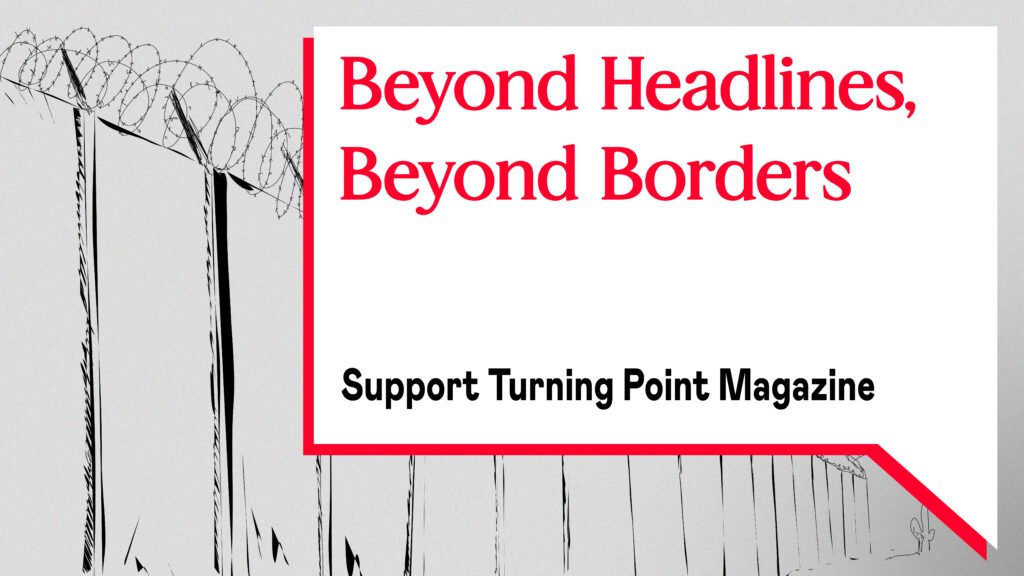Cover photo: Axuntase Housing Cooperative in the town of Llanera, in Asturias, Spain. ©David Aguilar Sánchez
Spain faces an ageing problem, with 15% fewer children and 35% more people over 80 years old than ten years ago. Currently, there are more than 5,500 elderly homes in the country, most of them private (73%). According to the data of the Institute for the Elderly and Social Services, a public agency under the Ministry of Social Rights, most of the users are over 80 years old and live in shared rooms in private centers with more than 100 beds.
In the last legislature, the center-left coalition government of the PSOE and Unidas Podemos approved a plan to put an end to the so-called macro-residences and promote a new model of public care on a more human scale. However, to date, only 38% of the rooms in elderly residences are single rooms, and only 14% of centers are fully under public management.
Unpaid care work of families continues to be the main alternative to aging in nursing centers. It practically always falls to women, with or without the help of other contracted persons (who also are typically women). Public contribution to the care work in homes is weak, barely reaching 5.5% of households with elderly or dependent people. The average home assistance for the most dependent only covers two hours a day, according to data from the Association of Directors and Managers of Social Services.
At the same time, Spain struggles with a crisis of affordable housing. In the past decade, the price per square meter has risen between 35% and 54% depending on the location. The rise in housing prices is most noticeable in the big cities and the areas with more tourism, the main engines of the Spanish economy: it offers great benefits for the real estate owners and a huge economic burden for those who pay a rent or a mortgage. The price of housing has become the main cause of poverty.
In this context, two old friends, Nieves Fernandez and Mariasun Rodriguez, decided to promote a collective alternative to the cold and de-personalized elderly residences, as well as to ageing isolated in an apartment and thus forcing sons and daughters to become 24/7 caregivers. But they also wanted to to confront the housing problem that is making life increasingly difficult also for young people. Thus, from this confluence of care crisis and housing crisis, the housing cooperative Axuntase was born in the town of Llanera, in Asturias, one of the most aged regions of Spain and Western Europe.
The name Axuntase is Asturian, a language in decline and without an institutional recognition comparable to that of Catalan, Basque and Galician. In English, it means “to get together” and summarizes what the housing project is all about.
Lifelong friends, Nieves and Mariasun, had speculated on the idea of living together with their families already in the 1980s when they were young, married, raising their children, and trying to break with the traditionalism of the earlier generation. However, the project of organizing a “commune” was shelved.
In 2014, retired and divorced from their respective husbands, and their children grown up, Nieves and Mariasun decided to sit down and crunch the numbers once again. They started imagining, down to earth, what it would be like to grow old together in “a community with people of all ages” instead of in isolation.

Daughters of the “baby boom,” Nieves and Mariasun come from large, working-class families. They are part of the first generation of Spaniards that had mass access to higher education and jobs in education and public services. They decided to become mothers, but they did not want to be only mothers and wives. For years, both women combined family, work inside and outside the home, and union militancy. Mariasun was also a political leader in Izquierda Unida and a councillor for the party in the Oviedo City Council. Used to collective work, she recognizes that Axuntase has been the most exciting challenge. But it is also the most complex and tortuous stretch of her social organizing trajectory that began in the 1970s with student militancy for democracy during the last years of Franco’s dictatorship.
Axuntase, which will open its doors at the end of this year, was on the verge of collapse several times. Obtaining funding and permits was not easy, and bringing together many people with different interests and life trajectories was even less so. Self-management and assembly can be enriching and stimulating, but they have never been a bed of roses or a love-fest.
“Many people have passed through Axuntase, but many have also left because the collective requires a lot of effort, and not everyone is willing to assume, for example, that your house is worth the same whether it is 52 or 75 square meters,” said Mariasun.
The single price of the houses, 172,000 euros, has been one of the most controversial points of the project. Mariasun explains that the reason for this decision is to encourage families with children to have access to the cooperative.
“All the houses are worth the same, and the size adapts to your needs. There is no environmental rationality for a single person to live in a big house. If the family grows, its house grows. If the family shrinks, so does the apartment,” she explained.
The unit price of Axuntase apartments is more than competitive in a country where housing costs are skyrocketing. Axuntase is pleased with the quality of the 36 apartments that have been built with the lowest energy consumption and maximum environmental sustainability in mind. The houses, which are powered by solar energy from their own energy community, are not excessively large. But in exchange they have large common spaces: laundry, collective kitchen, dining room, a large assembly hall, and an estate of more than 10,000 square meters with an orchard and fruit trees.
The cooperative seeks a balance between the individual, the family, and the collective. Each house has its own living room and kitchen so that each person or family can have intimate life there. At the same time, it is mandatory to get involved in the maintenance of the common space, for example, by helping in the kitchen shifts. At noon, a daily menu is offered to the residents by a cook hired at the cooperative. The ingredients are purchased collectively, prioritizing local and organic products. There is also a cleaning service for all the apartments and common areas, contracted to another cooperative. But residents are also asked to lend a hand in these tasks.
Axuntase’s project is based on collective ownership and the transfer of use. Masiasun considers it “totally revolutionary” as it challenges the rules of the real estate sector.
“You use the housing as long as you want, but you cannot speculate with it. If you leave, you recover your investment, but you don’t sell it,” she said. “This prevents the project from becoming a speculative business.”
The houses will always belong to the cooperative. If someone dies, the heirs can choose between going to live in the house they inherit or receiving the money that their relatives once contributed to the cooperative.
Another novelty of Axuntase is that the common spaces will be open to the people and other associations. “Our idea is to have summer cinema, street markets, theater, workshops…” said Mariasun.
Making this dream possible has cost the cooperative seven million euros and many hours of effort. The promoters are neither wealthy nor experienced in real estate sector. Despite this, they managed to win the confidence of the ethical bank Fiare which was attracted by the social content and the solvency of the project. On the negative side, they regret the lack of public support for a project that will guarantee affordable housing for some 60 people without aiming at private profit, as is the case with the construction companies that build social housing under public-private partnership schemes.
In contrast to the traditional welfare state and neoliberal public-private collaborations, Mariasun calls for a “third way,” public-community collaboration. The state should provide resources while the community provides labour, participation, and dynamism that is usually lacking in public administration.
Mariasun said that neither she nor Nieves had heard of “cohousing” or “collaborative housing” when they began to imagine Axuntase. However, once they got into it, they began to document and learn from other initiatives along the same lines.
At first, they looked at various experiences in Denmark. Then, they discovered the Uruguayan model and traveled there to learn about it first hand. Now they believe that Uruguay’s cooperative housing model could be a source of inspiration for Spain. With a population of only three and a half million people, Uruguay has more than 3,000 housing cooperatives. They are supported by the state with financing and land transfers, and it is estimated that they are able to build 20-25% cheaper houses than those on the market.
Mariasun believes that the community model makes things easy for both those who are raising their children and those who are in the final stretch of their lives. She does not hush-hush the thorny aspects of ageing.
“Some people will become dependent over the years,” she said. “Dependency that is well cared for is very expensive, but care is affordable by collectivizing its costs.”
For the veteran activist, individualism lays behind the difficulties to grow up and to die. That is why she considers that Axuntase is about “recovering humanity,” both in those who are taking their first steps in life and in those who are preparing to say goodbye to it.




